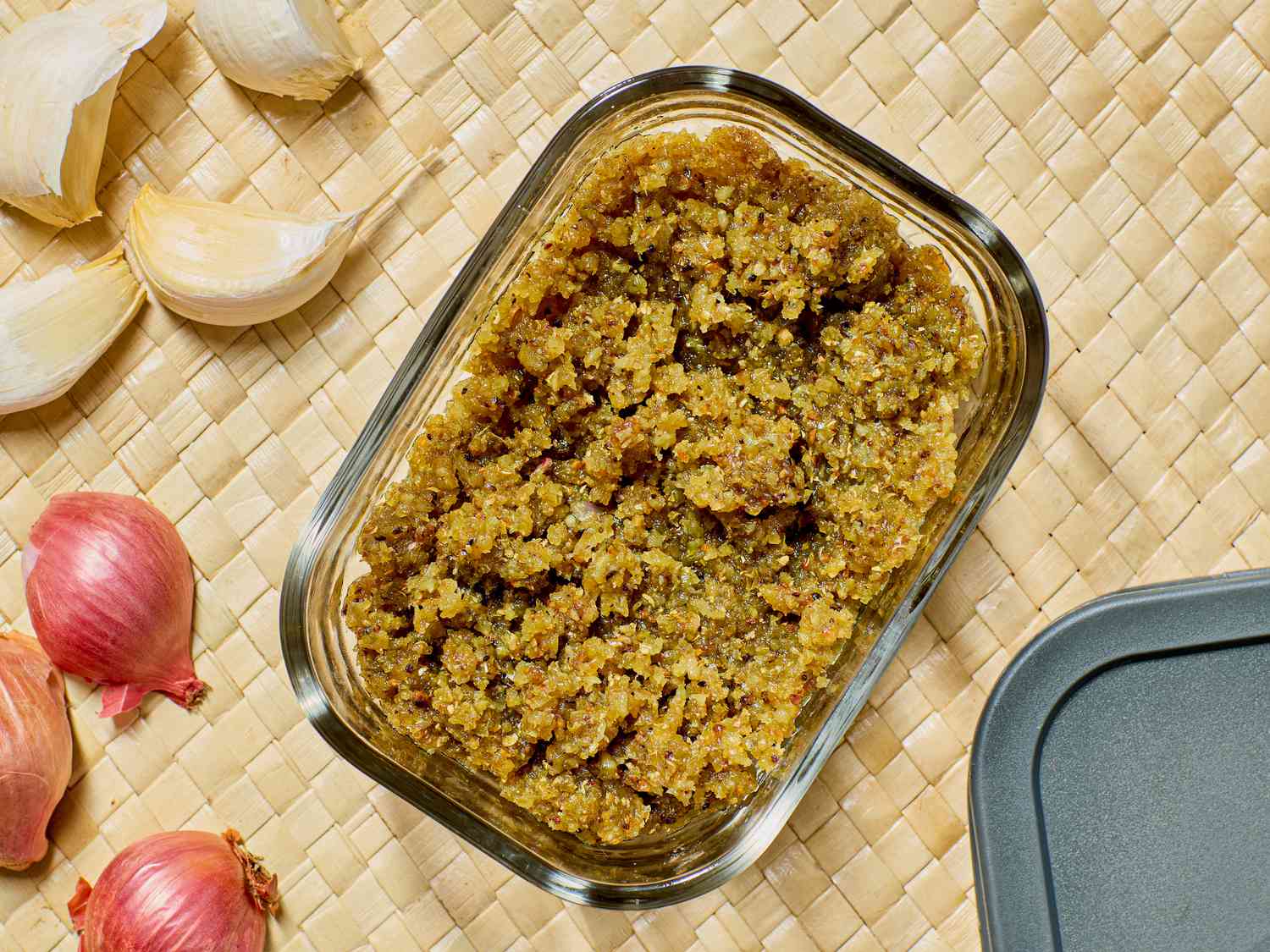
[ad_1]

Why It Works
- Frying the paste further concentrates its flavor and removes moisture while increasing its shelf life.
- Toasting the candlenuts and spices enhances the flavor of the spice paste.
- We provide two different methods: one with the food processor for speed and ease, and another for the more traditional mortar and pestle, which produces a more aromatic paste.
In Indonesian cuisine, spice pastes called bumbu bumbu—repeating the noun makes it plural— are the cornerstone of many dishes. This white spice paste, known as bumbu dasar putih, is one of several bumbu dasar (basic pastes) that serve as the foundation for many Indonesian dishes. It’s typically made with garlic, shallots, candlenuts, and coriander, but some cooks may incorporate aromatics like makrut lime leaves, galangal, and/or lemongrass to add complexity to it. Like other Indonesian spice pastes, bumbu dasar putih is named for its color. Unlike other deeply hued and bold spice pastes, however, this white one has a neutral taste that complements a wide range of ingredients.
Serious Eats / Melati Citrawireja
White spice paste is an easy way to flavor dishes, but I also use it as a base for preparing other bumbu dasar. For fiery red bumbu dasar merah, I incorporate spicy red chiles like Fresnos or bird’s eye chiles into it; for yellow bumbu dasar kuning, I add a hefty amount of earthy turmeric; and for black bumbu kluwek, I use the dark seed of the Pangium tree, which lends a smoky funkiness. These spice pastes are building blocks for many iconic Indonesian dishes: Crisp ayam goreng kunyit (turmeric-fried chicken) and my favorite chicken noodle soup, soto ayam, get their bright hue from bumbu dasar kuning, while bumbu dasar merah gives beef rendang (a dry beef curry) and telur balado (hard-boiled eggs in spicy sambal) bold heat. And rawon, a beef stew redolent with lime leaves and lemongrass, relies on bumbu dasar kluwek for its distinct earthy flavor and slight bitterness that’s reminiscent of dark chocolate and mushrooms.
Candlenuts (kemiri), a high-fat nut similar to macadamias, lend these spice pastes their velvety texture. Like walnuts, they have a mild, albeit slightly bitter flavor. Because they’re toxic when raw, they should only be consumed when fully cooked. Pounded candlenuts are used as a thickener in many Indonesian stews and curries. Though candlenuts are readily available online and at Southeast Asian grocery stores, you can substitute with macadamia nuts if you can’t find them. It’s rumored they’re called candlenuts because their high oil content makes them flammable, and they were once strung and used as candles.
What differentiates this white spice paste from others is its pleasant, mellow flavor. Because spice pastes are such a fundamental part of Indonesian cuisine, having ready-made bumbu dasar putih in the fridge makes it easier and faster for me to whip up treasured Indonesian meals, including opor ayam putih, a rich and creamy coconut-based chicken “curry” spiced with coriander and cumin. I make a big batch of white spice paste during the weekend, which sets me up for success all week long. With just a few tablespoons of bumbu dasar putih—which I fry in oil until fragrant before incorporating vegetables, proteins, and starches—I’m able to add exponentially more flavor to a simple stir-fry, soup, or fried rice.
Serious Eats / Melati Citrawireja
Like my Indonesian Chinese mother, preparing my own spice pastes from scratch has become a part of my cooking routine. When I was growing up in Singapore, my mother made bumbu bumbu the traditional way with a mortar and pestle. Every day, she’d prepare fresh spice pastes for dinner that evening. I’d come home from school in the early afternoon to find her sitting on a stool in the kitchen, steadily pounding away. Depending on what was for dinner, she’d incorporate other ingredients like chiles, turmeric, or galangal to flavor the spice paste—but garlic and shallots were always a must.
While I respect my mother’s commitment to the mortar and pestle, I do not have such an affinity. More often than not, I rely on my trusty food processor to churn out my spice pastes. Not only is it quicker, but it also produces a more evenly-textured paste. Through plenty of trial and error, I’ve found that pulsing the paste—instead of puréeing it continuously—prevents overprocessing, liquefying, or bruising the ingredients, and results in a creamier paste. When the spice paste is too thick, I’ll add just enough liquid like oil or water to keep the mixture turning around the blades. But if you find yourself unable to effectively pulse the paste, I recommend using a spatula to scrape as needed.
Though the food processor is a much more efficient method, I do enjoy the meditative practice of grinding ingredients with a mortar and pestle when I’m not in a rush—plus, a mortar and pestle crushes the ingredients instead of chopping them, which releases more of their aromas into the paste. Making spice paste in the food processor also requires the addition of a small amount of oil to keep everything turning in the bowl, but you won’t need oil when using the mortar and pestle, as the paste will create its own emulsion as you pound.
Here are tips to keep in mind if you choose to go the mortar and pestle route:
- Ingredients that are hard to pound, like coriander seeds, should be finely ground beforehand.
- Pound the ingredients in order of hard to soft. Start by grinding the candlenuts. Then, incorporate tough aromatics like lemongrass and galangal, if using, followed by softer ones like shallots and garlic. (All the aromatics should be roughly chopped beforehand.) Finally, add the finely ground coriander and white pepper.
- Add a pinch of salt with each ingredient. This increases the friction and helps to more effectively break down the ingredients as you pound.
[ad_2]
Zita boo
Ok